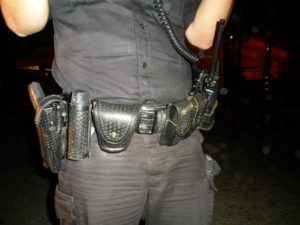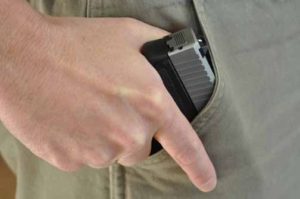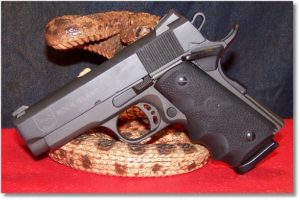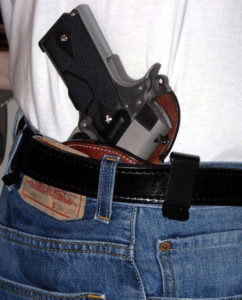 When I worked as a LEO, in a past lifetime, I carried a lot of equipment on my body. I don’t know what piece of equipment was heavier; the Motorola radio or the Colt Series 80 MK IV “Government” model pistol that was housed in a secure holster on my right hip. My off-duty carry was a Colt Series 80 MK IV “Commander” model pistol. The department forced me to consider a different EDC and a Sig Sauer P220 (at my expense) replaced the Colt for a while until the department changed its mind again and Smith & Wesson 686 revolvers were standard issue (at the department’s expense). None of these firearms were lightweight in any respect.
When I worked as a LEO, in a past lifetime, I carried a lot of equipment on my body. I don’t know what piece of equipment was heavier; the Motorola radio or the Colt Series 80 MK IV “Government” model pistol that was housed in a secure holster on my right hip. My off-duty carry was a Colt Series 80 MK IV “Commander” model pistol. The department forced me to consider a different EDC and a Sig Sauer P220 (at my expense) replaced the Colt for a while until the department changed its mind again and Smith & Wesson 686 revolvers were standard issue (at the department’s expense). None of these firearms were lightweight in any respect.
After leaving the department, the Colt Series 80 MK IV “Commander” model pistol (not the Lightweight Commander) was selected as my EDC. Since that time, I have carried a number of pistols and revolvers with some being small and light while others big and heavy and a few that were small and heavy. Of the three, I prefer the heavy and some question my sanity (as do I at times) for doing so.
 The popular theme today seems to be to carry the lightest and smallest pistol or revolver in the most powerful caliber that a person can sufficiently handle and shoot effectively. Since we are creatures of comfort, carrying a lightweight pistol or revolver is very enticing. The concept of carrying a firearm where it is not even noticeable to the user, in weight and size, appeals to most of us – including me. However, I have shot and carried my share of small, lightweight pistols and revolvers in my 40+ years of being seriously involved with firearms, but I’ll take a full-size, heavy pistol or revolver any day when it comes to facing the elephant. If nothing else, I prefer a compact, heavy handgun over many of the lightweight models available today.
The popular theme today seems to be to carry the lightest and smallest pistol or revolver in the most powerful caliber that a person can sufficiently handle and shoot effectively. Since we are creatures of comfort, carrying a lightweight pistol or revolver is very enticing. The concept of carrying a firearm where it is not even noticeable to the user, in weight and size, appeals to most of us – including me. However, I have shot and carried my share of small, lightweight pistols and revolvers in my 40+ years of being seriously involved with firearms, but I’ll take a full-size, heavy pistol or revolver any day when it comes to facing the elephant. If nothing else, I prefer a compact, heavy handgun over many of the lightweight models available today.
These days, I can normally be found carrying a Rock Island Armory 1911 FS, a Rock Island Armory 1911 MS Tactical, or a Rock Island Armory 1911 CS pistol – all of which are part of the “Rock” series of pistols. While these pistols are not “top-of-the-line” pistols, they have proven themselves to be capable of handling range duty and also facing the rage of a person who is intent on doing me harm. All three pistols are heavy in weight and big in caliber; I have full confidence in them.
When a person decides to carry a pistol or revolver for the purpose of self-defense, that person needs to be committed to master that pistol or revolver. While attempting to master a full size, heavy pistol or revolver is challenging enough, attempting to master a lightweight, compact pistol or revolver is much more of a challenge. Muzzle blast and flash, recoil, obtaining a proper grip, and trigger control contribute to hindering a person’s ability to shoot small, lightweight pistols and revolvers. Coupling all of this with a short sight radius makes accomplishing fast and accurate shots darn near impossible and sometimes forces folks to relegate the pistol or revolver to the nightstand drawer; never to be shot unless absolutely necessary and will rarely see range time. In my humble opinion, it is better to have a larger, heavier pistol or revolver that you will actually train with and shoot often to master.
 My current “summer” EDC is the Rock Island Armory 1911 CS pistol in .45 acp; an “Officer Model” 1911 with a 3.62” barrel. At 2.16 pounds unloaded, it is far from being a lightweight pistol. An advantage of the 1911-based pistol, over some other types of pistols, is that you can change out grip panels for better grip control. This particular pistol wears a Hogue Monogrip with finger grooves, which provides a little more girth to the handle for my hands. The finger grooves provide resting places for digits that do not have the responsibility of pulling the trigger or operating the magazine release and also for obtaining as high a hold on the handle as possible to help mitigate muzzle flip. The rubber composition of the grip helps mitigate some of the recoil impulse. Wilson Combat 7-round magazines provides the same number of rounds as a full-size 1911 and 8-round magazines provide extra ammunition should the need arise. The front sight has been painted fluorescent red for easy pickup by the eyes while the rear sight remains blacked-out. The Rock Island Armory 1911 CS pistol is a basic fighting pistol with no frills and it provides me with everything that I need; accuracy, dependability, and a major caliber that has been battle-proven.
My current “summer” EDC is the Rock Island Armory 1911 CS pistol in .45 acp; an “Officer Model” 1911 with a 3.62” barrel. At 2.16 pounds unloaded, it is far from being a lightweight pistol. An advantage of the 1911-based pistol, over some other types of pistols, is that you can change out grip panels for better grip control. This particular pistol wears a Hogue Monogrip with finger grooves, which provides a little more girth to the handle for my hands. The finger grooves provide resting places for digits that do not have the responsibility of pulling the trigger or operating the magazine release and also for obtaining as high a hold on the handle as possible to help mitigate muzzle flip. The rubber composition of the grip helps mitigate some of the recoil impulse. Wilson Combat 7-round magazines provides the same number of rounds as a full-size 1911 and 8-round magazines provide extra ammunition should the need arise. The front sight has been painted fluorescent red for easy pickup by the eyes while the rear sight remains blacked-out. The Rock Island Armory 1911 CS pistol is a basic fighting pistol with no frills and it provides me with everything that I need; accuracy, dependability, and a major caliber that has been battle-proven.
Even though the Rock Island Armory 1911 CS is a heavy pistol, mastering the operation of it is still a challenge and that means range and training time with it. Increased muzzle flip and blast are just part of shooting a short-barreled pistol two-handed let alone with one hand, which just may be your only recourse in a combat situation. I just find that handling a heavier weight handgun works more to my advantage rather than against it. To put things further in perspective (from my point of view), if I were offered a Ruger LCR or a Ruger SP101 in the same caliber, my choice would be the SP101.
Now, you might think that I am advocating that you run out and buy the heaviest, sub-compact pistol or revolver that you can find. That is not true. What I am advocating is that weight should weigh into your decision in your choice of handguns – lighter is not necessarily better. Along with caliber, the weight of a hand gun can make a difference in your performance with a hand gun (ergonomics and size notwithstanding). When I fire a Glock G30, I find that I actually have to grip it tighter than my “Commander Model” 1911 pistol. This may be comparing apples to oranges, but the polymer frame of the Glock G30 has different dynamics from that of the steel-framed 1911. I also have the same issue when shooting the Glock G19 (or any polymer-framed pistol) as compared to a Sig Sauer P239, a Sig Sauer P226, a CZ75, or a Beretta 92FS. With that said, I have no problems shooting the Glock G26, Glock G36, Glock G43, or Springfield XDs 9mm, but that may because of ergonomics rather than frame materials. I really don’t know. What I do know is that I shoot a heavier pistol and revolver better than I do with a lightweight pistol or revolver. And, when the chips are down and I need to use a pistol or revolver in a self-defense situation, a heavier pistol or revolver is preferred.
 When it comes to physically carrying a handgun, and in my opinion, the best place is still on the hip in a quality holster. The hips provide enough foundation to carry the load of even a heavy hand gun – short-barreled or long, compact or full-size. The choice of IWB or OWB is left to the carrier according to local gun laws and permits. Personally, I prefer IWB carry simply because I can cinch the firearm as close to the body as possible with the belt, which provides the most support for the hand gun as possible. I also wear suspender to help distribute the load and keep it above the hips.
When it comes to physically carrying a handgun, and in my opinion, the best place is still on the hip in a quality holster. The hips provide enough foundation to carry the load of even a heavy hand gun – short-barreled or long, compact or full-size. The choice of IWB or OWB is left to the carrier according to local gun laws and permits. Personally, I prefer IWB carry simply because I can cinch the firearm as close to the body as possible with the belt, which provides the most support for the hand gun as possible. I also wear suspender to help distribute the load and keep it above the hips.
To close this up, and if your considering a hand gun for self-defense, I advocate not only handling it at your local gun shop, and if available for rental, to shoot it at your local range before you lay down some hard-earned greenbacks for it. This will help you determine if the hand gun is the right one for you when shooting full-power defensive ammunition. The weight of a defensive pistol or revolver is not the only factor to judge in your purchasing/carrying decision, but it should be a factor to consider.
![]()

